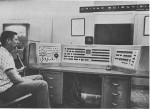 A U.S. Navy team had built some early code-breaking computers during World War II similar to the Colossus machine in Britain. After the war, the group formed Engineering Research Associates (ERA) to continue building computers for the military and commercial sectors.
A U.S. Navy team had built some early code-breaking computers during World War II similar to the Colossus machine in Britain. After the war, the group formed Engineering Research Associates (ERA) to continue building computers for the military and commercial sectors.
The first “Alpha” models initially funded by the U.S. Navy were delivered to the Army and the NSA. It is notably one of the first stored program computers that was ever built and then installed at a remote site.
The commercial version of the 1101 was revealed to the public in 1951, but by 1952 ERA was drained after a lengthy legal battle over conflict of interest claims due to the company’s military roots. The company was purchsed by Remington Rand around the same time as their acquisition of the Eckert-Mauchly Corporation, and was renamed the UNIVAC 1101 to capitalize on the name. Remington based a series of computers on the 1101 architecture well into the 1960s until it was finally phased out by newer technology. It continued to live on in name only in later Remington models.



